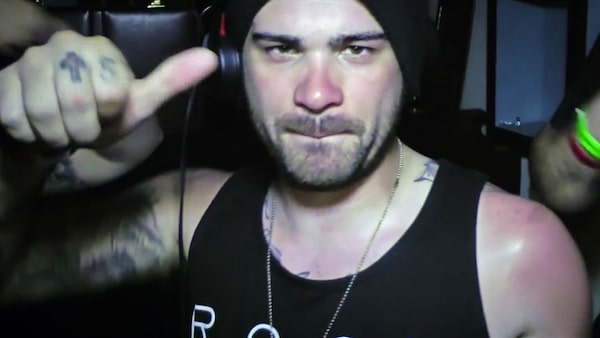
Hunter Moore in The Most Hated Man on the Internet.Courtesy of Netflix
We are still coming to grips with a collective understanding of our “Terms of Service” agreement with the internet. Almost weekly we read about new court cases in which the legality or illegality of some actions on the web are being tested. Mostly it’s about exploitation and privacy.
The Most Hated Man on the Internet (streams Netflix from Wednesday) revisits one of the most appalling instances of exploitation and privacy invasion. The three-part documentary chronicles the rise and downfall of one Hunter Moore. Roughly 10 years ago, this reckless sociopathic dweeb turned an existing website into a forum for revenge porn. The gist as presented was this: An ex would post nude or topless or other racy photos of a former girlfriend on the site to shame her.
This is one of those series that I watch on your behalf, because disgust isn’t the right word for what many might feel watching this journey into the shaming and loathing of women.
Catch up on the best streaming TV of 2021 with our holiday guide
To be fair, the series frames the story as one of righteous counter-insurgency. A mother goes after Moore when photos of her daughter appeared on the site. First, she got nowhere. But Moore and his acolytes messed with the wrong mom. Canny and relentless, Charlotte Laws was not going to give up or be worn down. (In the second part of the series, there’s a fascinating reveal about Laws and her own past.) It took time, but in February, 2015, Moore pleaded guilty to one count of unauthorized access to a protected computer to obtain information for purposes of private financial gain, and one count of aggravated identity theft. He was sentenced to 30 months in prison and fined.
How that finale was reached is the narrative here. Laws’s daughter was stunned when told photos of her were on the site. She hadn’t sent them to anyone. But the experience was worse than embarrassing. Moore’s utterly sociopathic trick was to connect the photos to a person’s social-media profile, meaning users of his site could find these victims with ease. Laws’s daughter, already traumatized, began getting obscene calls from random men.
Her mother contacted other victims and their parents. A pattern emerged. Many of the victims claimed the photos were private, not shared with anyone. So, how was Moore getting these photos?

Charlotte Laws went after Mr. Moore when photos of her daughter appeared on his site.Courtesy of Netflix
Some context is given to the phenomenon of a wild west internet that suddenly allowed total strangers to insult, bully and harass women. Moore’s site arrived almost simultaneously with smart phones that allowed easy access to the online world, by anyone from anywhere. Moore was a god of sorts to his followers. There were foolish women who wanted to gain notoriety by being on the site. In mainstream media coverage, Moore was called “an online renegade,” not the monster he was. It was all about these new ways of making money from new technology, and Moore made a lot of money.
After three hours, you are very tired of Moore. He didn’t participate in the series but his narcissism meant there is plenty of footage available. “I’m gonna be worth $100-million by the time I’m 30,” he says in one bit in the documentary. “I’m literally gonna take over the world.” He didn’t. Instead, he got caught, but not before he and his posse of obnoxious male friends had terrified so many women. Charlotte Laws also suffered through that male rage. A fax sent to her home stated, “We’ll rape you and put a shotgun down your throat.”
Eventually, Laws was instrumental in the passing of legislation against intimate-image abuse in 48 states in the U.S. And yes, the series successfully frames the entire story as one about a bully and boaster who tangled with the wrong mom. And no, the series does not use any images from the original site, those explicit images of young women, made public without their consent. What’s used are very blurred images from sites where people post their own sex-positive content of their own volition.
The missing perspective is one that looks at the male rage that ignited revenge porn. Moore isn’t the only culprit and what happened in the early years of internet bullying and shaming needs to be explored more fully. Watching it, I had a small sense of dread. Some people have learned from Hunter Moore, you see, and some of those people are powerful celebrities. They’ve learned the art of online shaming and wield it against critics and skeptics. Online mobbing is a phenomenon that’s continuing, and some people think it’s part of their Terms of Service.
Plan your screen time with the weekly What to Watch newsletter. Sign up today.